Base marking
The markings should be applied depending on the direction in which the lining will be located. Directionality can be both decorative and practical. For example, in saunas and steam rooms, it is recommended to give preference to the vertical sheathing method so that moisture deposited in the seams between the boards does not accumulate and has the ability to drain freely downward.
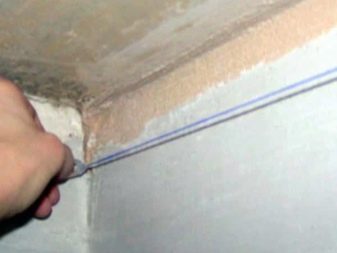
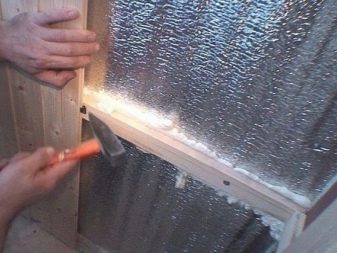
The horizontal markings should ensure that the bracket is positioned close enough to the floor to allow access for the hammer to attach the cleaimer. To increase the decorative effect of the finish, diagonal laying is also used, or several methods of installing the lining are combined to obtain unusual patterns on the walls or ceilings. These methods are typical for living quarters. In this case, it is difficult to do the job without experience and training. The lathing is usually installed perpendicular to the direction of the boards.
Mounting bracket selection method
The choice of clamps depends on the type of lining used in finishing works. The types of material differ in thickness and weight of the sheets, so the brackets for fastening must be of the required size and the height of the tongue corresponding to the task.
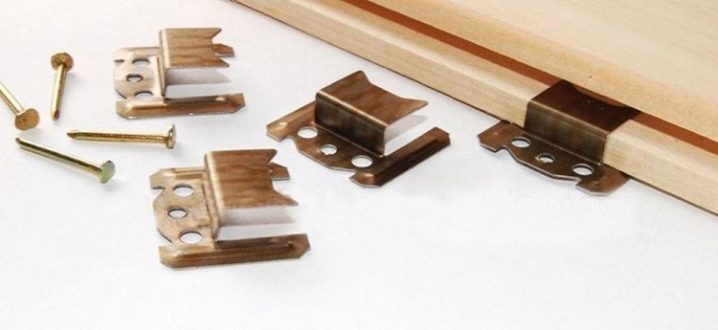
Lining made of plastic and finishing elements made of MDF can be mounted on clamps with a height of about 1-2 mm. Hardware with a three-millimeter tongue is used to install materials from a chipboard plate.
For fastening the euro lining, clamps are used, the tongue height of which is 4 mm. If ordinary wooden lining is used to decorate the house, then staples with a height of 5 mm are used to fix it on the working surface. The most powerful fasteners are required for the block house. It should be fixed with hardware clips with a tongue 6 mm high.
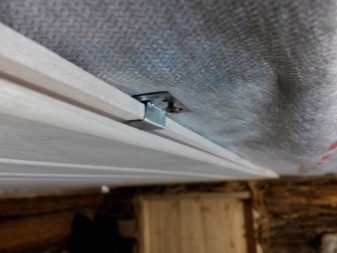
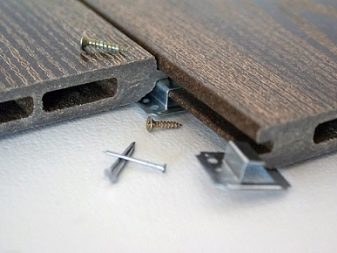
The most reliable are clasp staples, the thickness of which is 0.5 mm. They are made of zinc-coated steel, therefore they are not afraid of corrosion and are durable. Thanks to this, the details can be equally successfully used for both interior decoration and exterior work.
Today, clasps with barbed hooks are also on sale. Such staples are driven into the ends of the lining, creating the effect of additional fixation of the wooden board. There are several types of such elements. You can choose the right option based on the thickness of the board to which the part will be attached. For euro lining, clamps No. 3 and No. 4 are selected, for aspen and linden boards - No. 5 and No. 6, for plastic lining, kleimer No. 2 is taken.
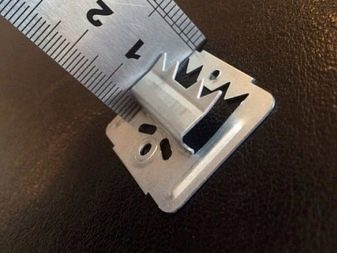

How to attach the lining to the clamps
When the lining and the type of fastening are chosen, the question usually arises of how to fasten the lining with clamps. This process is quite simple, but to make it easier, you can watch special training videos.
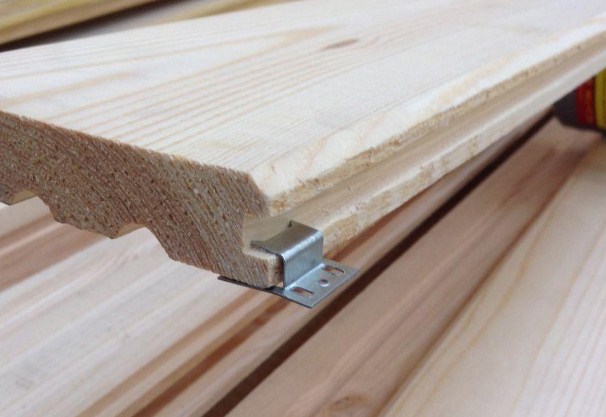
Carriage panels can be installed both horizontally and vertically, everything will depend on personal wishes. Vertical panels, for example, will visually enlarge the room, and horizontal ones will visually make the narrow one a little wider. And the method of installation will already be selected depending on the type of fastening of the lining.
When the vertical mount is selected, the first plank is mounted in a corner, leveling it with a level. In the middle of the carriage panel, in a special groove, a bracket is fixed, which is attached to the frame with nails or screws. The third part, which it picks up, is cut off from the next bar and fastened under the first. The element that remains is mounted in the groove to the first panel.
On each carriage rail, fasteners for the clapboard are installed, about 4 pieces. All of them must be screwed to the frame, in order to avoid deformation of the entire coating in the future.
The second and subsequent carriage panels are inserted into the grooves to the already installed ones, and from the reverse side, they are mounted with special fasteners to the crate.
When it is customary to sheathe the walls with panels horizontally, then the attachment of the planks must be made up with thorns. This will contribute to better ventilation, and therefore mold and mildew will be less dangerous, as well as prevent the collection of water or dust between the carriages. Carriage panels are mounted with horizontal cladding from bottom to top. On the bottom row, the brackets should be fixed a couple of millimeters above the floor. And the outer panel is cut in such a way that the remaining distance is completely covered.
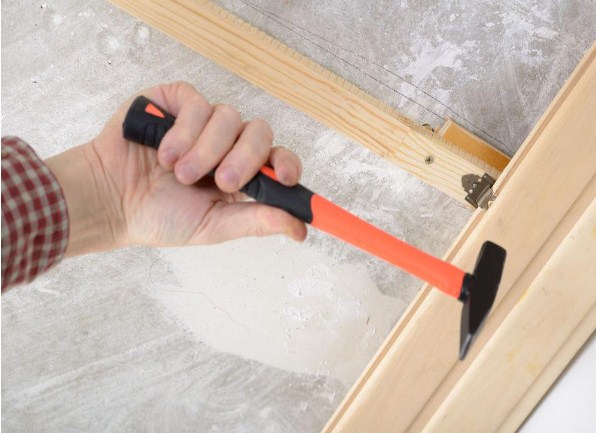
This work is quite painstaking, so there is no need to rush here. And in order for the wall cladding to turn out perfectly flat, it is necessary to regularly check with the level how all the cladding elements are laid.
Installation of the lathing
The lathing helps you get started with panel installation without the need to perfectly align the walls. This is especially true for concrete or brick foundations that simply aren't 100% even. We level the wall as far as we can and proceed to the next stage.
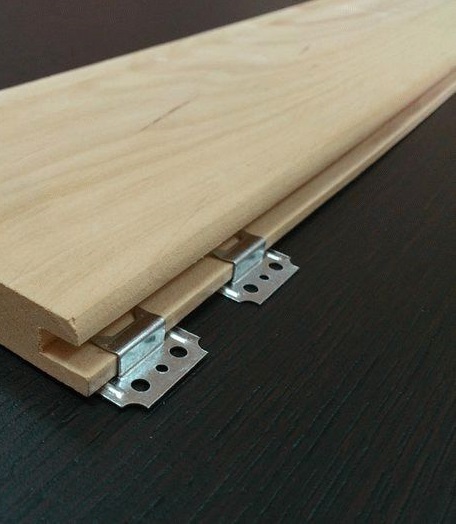
It is important to use the building level during installation. Otherwise, the curvature of decorative lamellas may appear, which will be conspicuous and spoil the aesthetic properties of the finish; The distance between the bars should be at least 60 cm, this will help prevent deformation or deflection of the lining planks
The distance between the bars should be at least 60 cm, this will help prevent deformation or deflection of the lining strips.
Clamp fixation
At the moment when it is time to start fixing the fasteners, the surface lathing and wall leveling should already be prepared. For fastening with nails, it is necessary to prepare the nails themselves, a building level and a hammer in advance, if self-tapping screws are used for these purposes, you need to take a screwdriver or screwdriver.
It is important to understand that the installation of wood panels and fasteners is carried out alternately. It is very important to remember the accuracy of calculations and the correct position of the hardware.
The most important thing is to pay attention to the fastening of the first element, and then the installation of all other parts will not be difficult.
For those who use self-tapping screws, the lathing will also not be superfluous. With its help, it will be easier to fix all the details. For convenient installation, we make marks in advance in the places where you need to screw in the screws, or you can pre-drill holes that are smaller in diameter than the screws. The work goes like this: kleimers are installed, lining is attached to them, then hardware is installed for the next lamella.
Where to start
First of all, before starting this kind of work, the surface is marked. For this, special measuring devices are used, and marks are made on the wall so that, subsequently, the fastenings are as even as possible.
Therefore, this stage should be given special attention, since the final result and the general appearance of the lined surface will depend on this.
To achieve the best result, a wooden frame is fixed on the wall, and the lining is fastened to the clamps on it. The distance between the parts of the lathing should be about 50 cm. All wooden parts are pre-treated with antiseptics, since this material is most susceptible to the influence of external climatic conditions. If necessary, insulation is placed in the crate cells. And only after all the preparatory work is completed, the frame is installed, you can start fixing the lining with the help of clamps.
Before attaching the brackets to the crate, you will need to prepare the necessary tools and materials:
- nails and hammer,
- or self-tapping screws and a screwdriver or screwdriver.
To understand the whole technology of fastening with such brackets, you need to know that you will need to fix the fasteners and carriage panels one by one. This process is quite simple, but it is necessary to observe the correct technology and adhere to the calculations made, since absolute accuracy is important here. After installing the first clamps, you can begin the installation of the first carriage boards, and then fasten the brackets again. Continue this process until the entire surface is sheathed.
Rules for calculating the stamps and their application for fastening
The experience of using kleimers shows that to securely and firmly fix one square meter, it is quite enough to pick up about ten pieces.
- For a more accurate calculation, you need to measure the length of one panel. After that, we measure the pitch of the sheathing frame. Typically, this distance ranges from 40 to 60 centimeters. We divide the length of the panel by the lathing step and add one. We multiply this result by the number of panels. This will be the right amount for fastening.
- When choosing the type of product used for fixing panels, it is necessary to take into account that each element must be fastened with two or three self-tapping screws. It is not worth saving on their quantity, as this can affect the reliability and quality of installation in general. For the fastening of heavy panels, thicker reinforced elements with a large number of points of their fastening are used.
- After calculating the number of clippers, you can start installing the panels. The wall on which the installation is planned is pre-treated with special antiseptic solutions to eliminate the possibility of fungus formation. In the future, clamps are installed on the wall or the installed crate with the help of nails or self-tapping screws. In this case, nails are used only in the case of using a lathing.
- Since the use of lining requires a flat surface, then in the presence of uneven walls, it is necessary to calculate how best to align them. Perhaps leveling the wall surface with a special mortar or installing lathing.
- Very often, in such cases, a crate is used, which is quickly installed on the surface of the wall, and you can immediately install it on it. Usually, the lathing is made of a wooden bar of the same thickness, which is fixed at a distance of about one meter from each other. When installing a wooden lining, this distance is slightly less, and is about 50-60 cm.
- When installing the lathing timber, you need to constantly monitor the plane of the resulting surface, which should be flat. If necessary, to obtain a flat surface, plates of the required thickness are placed under the bars.

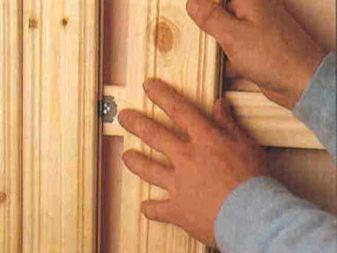
- The use of leveling solutions takes a long time, after which time is also needed for them to dry. Therefore, this option is used much less often and if necessary to carry out such work.
- Having installed the fasteners for the first panel, proceed to its installation and the subsequent fastening of the clamps for the next one. The first board is tightly inserted into the hooks of the kleimers, the rest are mounted in the same way. This method ensures an accurate and secure fit of each panel to each other.
- To ensure high-quality installation with natural further ventilation, it is necessary to take into account that the boards should not touch the wall surface. Otherwise it will lead to limited ventilation, moisture build-up, mold and mildew formation.
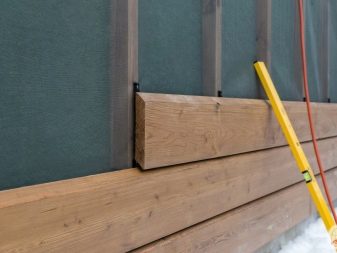
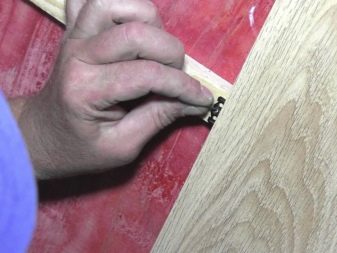
- When working with clapboard and cleats, it should be noted that work should be carried out at an ambient temperature of at least 10 degrees, since at lower temperatures deformation of the panels can occur. Clays must be made of stainless materials and are treated with a special protective coating, since rust can spread over the surface of the lining.
- You cannot use liquid sealant at the joints of wooden panels, but it is better to choose a moisture-proof film for this. Its use at temperature extremes can lead to cracking of the panels. After the installation is completed, the surface of the lining should be treated with special protective antiseptic materials that increase its resistance to precipitation and ultraviolet radiation.
- Taking into account all the requirements for the selection of clamps for lining will provide reliable and durable installation, as well as a long service life of the installed coating.
For information on how to attach clamps for lining, see the next video.
How to choose the right kleimers
You can choose cleats for installing lining and plastic according to the dimensions of the panels and their materials. The staples are classified by the size of the tab or tongue that is used to support the locating sheet. There are such types:
- For installing chipboard. The thickness of the elements is 4 mm;
- For the installation of plastic lining and MDF. Up to 2 mm;
- For fastening panels made of Euro lining, brackets up to 4 mm thick are used;
- For classic wooden lining, fasteners are used 5 mm;
Also, in some cases, the dimensions of the sheet are selected individually, depending on the thickness and material of the panels, as well as on the place of their installation. It is most convenient to buy fasteners in bulk at once, this will significantly save your time and money.
In hardware stores, the classification of kleimers is carried out by numbers. For example, when installing aspen panels, brackets 5 and 6 are used for the ceiling, and for Euro lining 4. Check the information directly with the seller so as not to confuse the fasteners.
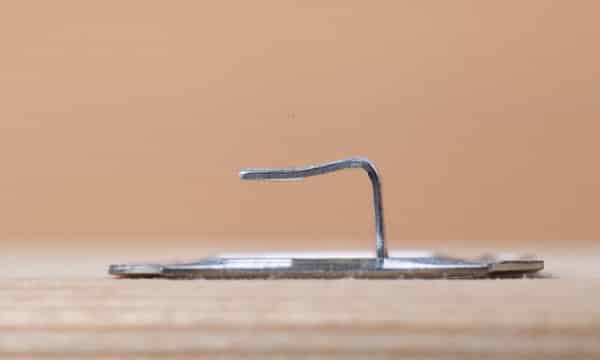 Photo - steel kleimer
Photo - steel kleimer
In the process of choosing clearers, a prerequisite is that you need to take into account the thickness of the material used in finishing work.
It is very important to use only those clapboard brackets that correspond to the dimensions of the product that you plan to use for cladding a particular structure
If we talk about the consumption of these fasteners, then you will need about 20 pieces to finish one square meter. Claymers have a relatively low cost, so you can safely purchase these parts with a margin - in any case, it will cost you less than buying other types of hardware.
The main requirement when choosing cleats for lining is dimensions. It is from the parameters of your panels and the type of material that you determine the appropriate option for fasteners so that they provide the expected reliability of the coating, but are invisible upon completion of all finishing work.
Having decided where to buy clays for lining, consider the following recommendations for the purpose:
- staples up to 2 mm - the optimal solution for assembling structures from plastic panels and MDF-type plates;
- 3 and 4 mm fasteners are purchased when clamps are needed for euro lining or chipboard;
- 5 mm fasteners - to solve the question of how to fix the lining made of wood, especially of such species as aspen, linden;
- 6mm products are used for the blockhouse.
-
strength of steel;
-
the integrity of the galvanized;
-
consistency of dimensional parameters of the entire batch.
The described fasteners for lining are so common among consumers today for a variety of reasons. Among others, it is possible to highlight the possibility of carrying out installation work in a room, the conditions of which are characterized by a high level of air humidity. Among other things, such fasteners are quite simple to use, even an employee who does not have enough experience can perform manipulations.

The main requirement when choosing cleats for lining is dimensions.
Specifically from the characteristics of your panels and type, determine a suitable option for fasteners so that they provide the expected reliability of the coating, but are invisible upon completion of all finishing work.
Having decided where to buy clays for lining, consider the following tips for appointment:
- staples up to 2 mm middle solution for assembling structures made of plastic panels and MDF boards;
- 3 and 4 mm fasteners are received when clamps are needed for Euro lining or chipboard;
- 5 mm fasteners to solve the question, how to fix the lining made of wood, especially of such species as aspen, linden;
- 6mm products are used for the blockhouse.
-
strength of steel;
-
the integrity of the galvanized;
-
consistency of dimensional characteristics of the entire batch.
Useful Tips

It is recommended to buy clamps for lining in proven hardware stores. This eliminates the likelihood of getting a fake, instead of high-quality material, which will lead to a quick failure of the kleimers.
It is also not recommended to use a liquid sealant for the formation of joints, this can affect the condition of the fasteners and provoke corrosion.
To protect both the lining panels themselves and the fasteners, after completing the work, it is imperative to cover the lamellas with varnish, wax or stain.
The installation of panels in a horizontal manner starts from the upper corner. This will help to preserve the aesthetics of the last plank, and if it needs to be shortened when installing the extreme lamella, this flaw can be covered with a skirting board.
Holes for sockets and switches are made before varnishing the lining.
To decorate the room with wooden clapboard, before starting work, the wall itself must also be treated with a primer.
The purchased material (lining) must lie in the room for at least a day before installation. This will help to avoid problems after expansion or contraction of the material as a result of changes in temperature and humidity.
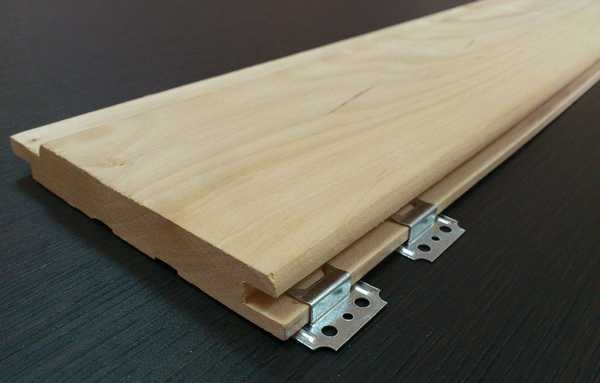
In order to hide the space between the first lining strip and the floor, it is necessary to use a skirting board specially provided for this.
When buying kleimers, it is important to pay attention to the material from which they are made. This is especially true when purchasing outdoor cladding mounts.
Compliance with the following simple rules will extend the life of the lining and retain its original appearance for a long time:
- kleimers should be purchased in specialized hardware stores, which will eliminate the risk of counterfeiting and prevent corrosion and quick failure of the fastening brackets;
- in order to avoid the appearance of rust and the destruction of hardware, it is not recommended to use liquid sealants to form joints;
- after the completion of installation work, the lining should be covered with a varnish, oil or wax composition - such a coating will help protect the material from the aggressive effects of sunlight and excessive moisture;
- when installing the lining, direct contact of the lamellas with the base surface should not be allowed - this can adversely affect the ventilation of the walls and cause the formation of fungus and the appearance of mold;
- cutting holes for sockets and switches should be carried out using a flared saw immediately after cladding, before applying varnish or wax;
- the space left near the floor is hidden with the help of a decorative skirting board that matches the color and texture.
You can find out the fastest way to mount a race in the video below.
Fastening the lining with clamps
Finishing studs are available with different types of coatings and are selected depending on the location and type of finish:
- black - fasteners made of steel without an additional anti-corrosion layer for work in completely dry rooms;
- galvanized - an inexpensive and most popular variety, a zinc layer gives reliable protection, products are suitable for use in all types of structures that do not have direct contact with water;
- with a copper, brass, chrome or bronze coating - more expensive types of fasteners that can be used in rooms with high humidity and in open spaces, with increased requirements for aesthetic finish, when working with expensive types of wooden lining.
Any novice craftsman who knows how to use a hammer can handle the job. Also, during the installation process, a doboiner is used - the device allows you to drown the head of the carnation without damaging the material.
 Using a finishing nail docker
Using a finishing nail docker
With the vertical arrangement of the panels (the crate must be horizontal), installation is carried out in the following sequence:
- Put the first part with a spike in the corner (for reliability, it is better to fix the first and last part with self-tapping screws, close the caps with decorative plugs to match the panel).
- Attach the finishing studs to the battens of the sheathing through the groove at an angle of 45 degrees using a hammer with light blows.
- Insert the second panel with a spike into the groove of the first one, lightly knock the panel with a hammer through a piece of lining or a block. Check the level of evenness of the masonry.
- Attach through the groove with nails to the crate, etc.
Fastening with a horizontal arrangement is carried out using a similar technology.
When using nails, they are hammered into the groove of the lining at an angle, completely sinking the head into the wood. In order not to damage the bar, you can use a doboiner. Screws are screwed in the same way, also making sure that they do not protrude and do not interfere with the "planting" of the next board.
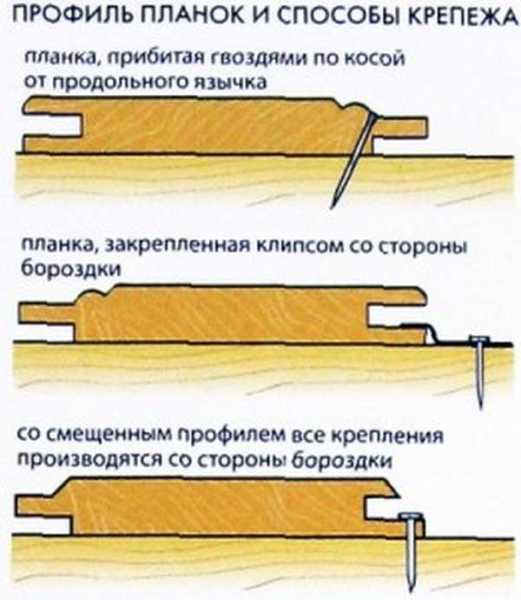 Installation of lining with finishing nails. Variants
Installation of lining with finishing nails. Variants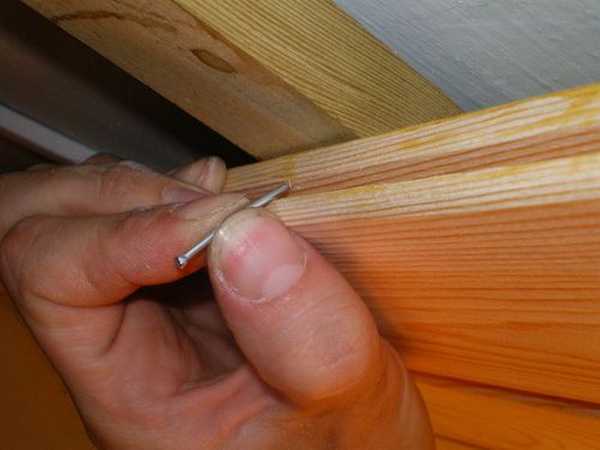 Is it possible to fix the lining in the bath with finishing nails
Is it possible to fix the lining in the bath with finishing nails
There is another option - to simply hammer nails into the lining, sinking the heads deeply (with or without drilling). Cover the resulting grooves with joiner's putty. It is much easier to do this, but not everyone is satisfied with this option from the point of view of aesthetics: it is quite problematic to make traces of nails / screws completely invisible.
You can make your own wood putty that matches the color perfectly. To do this, mix the smallest shavings, or better the dust that forms when the lining is cut, with a small amount of PVA glue to the state of a thick slurry. This composition and cover up all the grooves.
 Finishing nails for lining
Finishing nails for lining
It is better to take finishing nails for lining in the bath with copper, brass or chrome plating. They will withstand high humidity and will not deteriorate prematurely.
The first board is installed in the same way as when installing the lining with nails. It's all about how it is fixed. Kleimers are put on the thorn, which are attached to the crate with nails / staples / self-tapping screws. There are three holes for fasteners in them, but you choose to use all or only two (it is dangerous to fasten the lining in the bath for one nail / self-tapping screw - it can pull out). Nails or self-tapping screws are supplied with the clamps. If you "sit" on self-tapping screws, it is better to have a screwdriver - this will speed up the process at times.
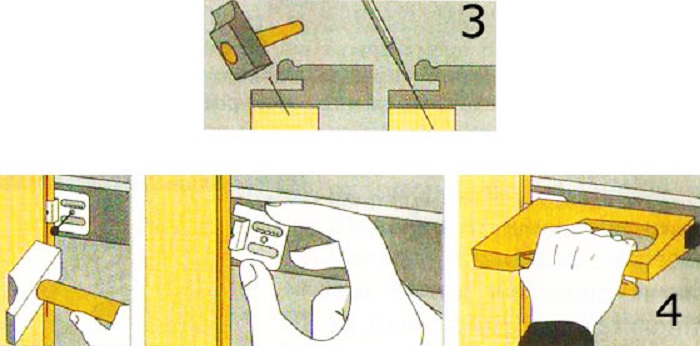
You can use a construction stapler to fasten the cleats, but you also need to be able to use it. It all depends on how hard you pull the trigger. If you press weakly, the bracket will not fully enter the wood, you will have to either shoot another bracket, or "finish off" this one with a hammer.
The fixing scheme in any case is no different from fastening with nails: first, fix the kleimer in the middle, then along the edges, and, after checking the vertical / horizontal installation, to all other intermediate battens of the crate.
Fasten the lining to the ceiling according to the same principles as on the walls: first, a wooden frame is assembled, adjusted to the level. A lining is attached to it - on clamps or nails - you choose. Both methods have a right to exist.
It is more convenient to lay the lining with a spike "towards you". The principle is the same: you lay the first lining board, stepping back from the wall 1-2 cm.It can be fixed with nails along the wall - then a corner or plinth will be attached on top. Then from the side of the thorn, at the intersection of the lining with the crate, either install clamps, or drive in nails at an angle.
Conclusion: You can fix the lining yourself. There is nothing super complicated about it. It takes time, accuracy and patience (except for lining and fasteners).
How the need for clays is calculated
Since clamps or staples must securely fix the panel in the intended place on the wall, their number depends mainly on the length of the lining. For euro lining, manufacturers usually complete the specified volume of material with the required amount of fasteners, which is easily installed according to the attached instructions. In other cases, they are guided by the following practical recommendations:
- For every 400-500 mm of the wall, at least four fasteners with a length of at least 1.5-2 mm are required.
- For fastening the lining on complex surface elements (ledges, bay windows), at least five units of fasteners are required for a length of 300-400 mm.
- For fastening the lining in the corners (for example, at window or doorways), the number of cleats increases to six, while the length between adjacent fasteners for the lining should not be more than 250 mm.
- For fastening the material at the points of its attachment to the frieze, the number of lining fasteners is taken from the calculation: four clamps per 250-400 mm of the panel length.
Thus, based on the row of installation of the lining, as well as the complexity of the perimeter of the premises, it is possible to quite accurately determine the need for these hardware.

Installation with clamps is very neat
In addition to the products under consideration, you will also need screws or self-tapping screws with which the kleimer is attached to the crate. Their number is determined by the design. Usually, the construction bracket and the clearer have three fastening holes, although there may be other versions (in particular, for Euro lining).
Advantages
The hidden method of fastening the lining by means of clamps has gained increased popularity for a reason. Thanks to its application, the finishing work process has been significantly accelerated. In addition, the use of clasp hardware minimizes the risk of material damage, splits and cracks, which often happens when using standard fasteners made of nails and screws.
Cleamers are selected individually for the type of lining used in the work. The high degree of fixation of such hardware is a guarantee that in the future the boards fixed with such brackets will be motionless, will not give backlash and will not loosen.
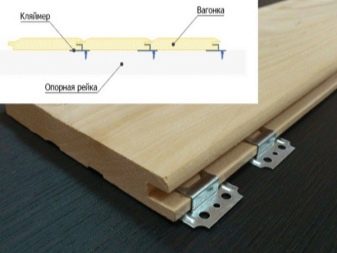
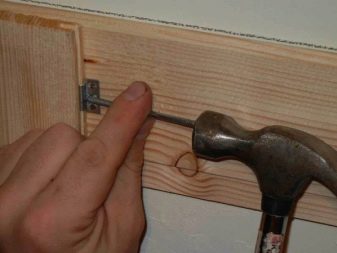
The use of clearers does not imply the use of any additional accessories. For the installation, the brackets themselves and nails or self-tapping screws are enough, which complete the fixation.
All products of this type have an anti-corrosion coating or are made of stainless steel. Due to this, the reliability and service life of the parts is increased many times over.

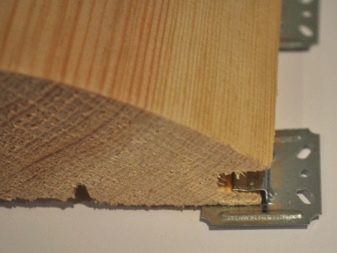
The installation of the lining and its dismantling in this way is performed quite quickly. Cleamers are practically invisible, so the structure has a holistic look, without gaps and indents, any damage and protruding fasteners such as nail heads and screw heads.
Installation with the use of such hardware is simple, does not require the use of special tools.
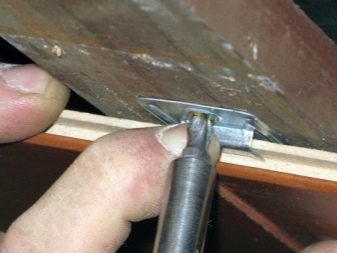

What are kleimers, their advantages
The high consumer demand and popularity of kleimers are due to the many indisputable advantages of this type of fastener.
- The simplicity of the design and the uncomplicated installation process allow you to independently perform the facing of the room without resorting to the services of specialists, and the exact observance of the installation technology will significantly reduce the time of work.
- The use of staples eliminates drilling, nailing and other mechanical impact on the lamellas of the lining, due to which the appearance of cracks and chips becomes impossible.This is one of the advantages of using fastening clamps over installation, carried out using self-tapping screws, nails and screws.
- A large size range of models allows you to form a neat seamless coating even when using the technique of combining the lining with other finishing materials.
- Reliable fixation, which is achieved with the help of clamps, completely eliminates the risk of deformation and shear of the coating.
- Kleimers are highly resistant to aggressive environmental influences and high humidity, so they can be used both in freezing temperatures and when decorating baths and saunas.
- Comfortable cost. The price of kleimers compares favorably with the price of other types of hardware.
- The versatility of the design allows the use of brackets when installing the lining on any rough surfaces, including wood, concrete, cinder block, cement bases and lathing.
The disadvantages of clapboards for lining include insufficient reliability under the influence of increased loads or foundation vibrations.
Kleimers are made of galvanized iron or spring steel. They are special brackets for fixing the lining, which are installed on a wall or lathing using self-tapping screws or nails. Cleamers are also used for fixing plastic boards and fixing MDF panels.
Clamps for fixing the lining are easy to purchase at any hardware store, and the low price is another advantage. Of course, buying nails and screws is a little more profitable, but the practicality of use and ease of installation with their help fully justify these costs. But besides this, there are a number of other advantages:
- The construction process is 2-3 times faster;
- Installation using cleats completely eliminates damage to the finishing material (cracks and chips), due to the fact that the panel itself does not need to be drilled or nailed to fix it;
- Such a fastener is not afraid of constant exposure to high humidity. And it is best suited for indoor use like a bath;
- Ease of installation: even an inexperienced person can master the technology of using clearers;
- There is a wide selection of cleats that differ in size, and this will allow you to choose a fastener that will facilitate fastening in a hidden way and without seams;
- Reliable fixation of trim panels, without possible shift in the future;
- Cleamers are very reliable, they are not subject to corrosion and destruction, and are highly durable.
